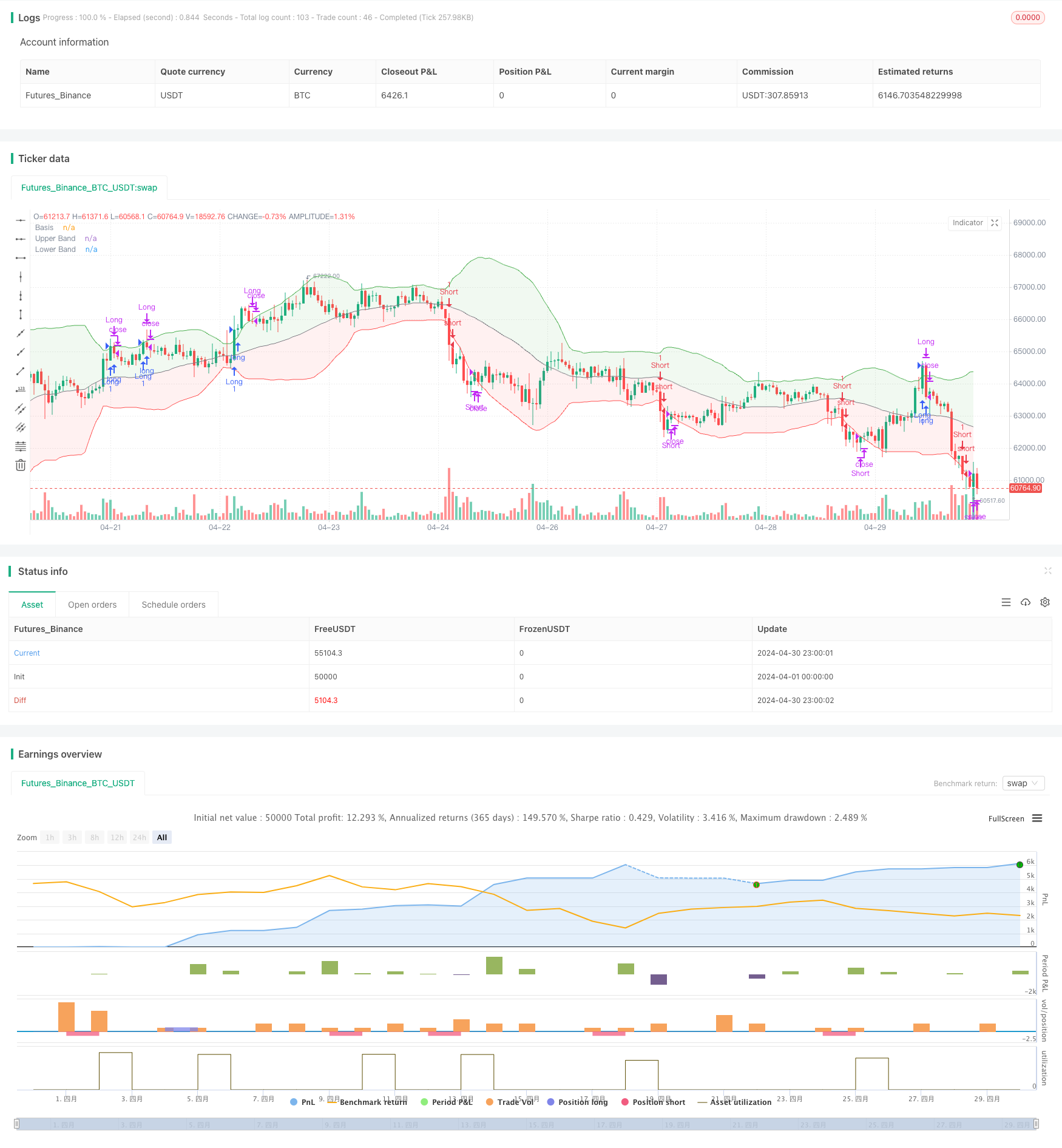
概述
动态布林带突破策略是一种基于布林带指标的交易策略。该策略利用布林带上下轨作为动态支撑位和阻力位,当价格突破上轨时买入,突破下轨时卖出。布林带由中轨(移动平均线)、上轨(中轨加标准差的倍数)和下轨(中轨减标准差的倍数)组成,可以动态调整以适应市场波动。
策略原理
- 计算布林带的中轨、上轨和下轨。中轨为收盘价的简单移动平均线,上轨为中轨加上标准差的倍数,下轨为中轨减去标准差的倍数。
- 当价格上穿布林带上轨时,开仓做多;当价格下穿布林带下轨时,开仓做空。
- 当做多仓位存在时,如果价格下穿布林带上轨,平掉多头仓位;当做空仓位存在时,如果价格上穿布林带下轨,平掉空头仓位。
策略优势
- 布林带能够动态调整,适应不同的市场波动状况,具有一定的自适应性。
- 策略逻辑清晰,容易理解和实现。
- 布林带在市场趋势性较强的时候效果较好,可以有效捕捉趋势。
策略风险
- 在市场波动较大、走势震荡的情况下,该策略可能会频繁交易,导致交易成本增加。
- 布林带参数(如移动平均期间和标准差倍数)的选择会影响策略表现,不同参数可能带来不同结果。
- 该策略没有考虑其他技术指标或基本面因素,仅依赖价格与布林带的关系进行交易决策,可能面临单一信号带来的风险。
策略优化方向
- 引入其他技术指标(如RSI、MACD等)作为过滤条件,以确认布林带突破的有效性,提高信号质量。
- 对布林带参数进行优化,通过回测和参数扫描,寻找最佳的移动平均期间和标准差倍数组合。
- 设置合适的止损和止盈水平,控制单次交易风险和盈利目标。
- 考虑市场状态和波动性,在不同市场状态下动态调整策略参数或仓位大小。
总结
动态布林带突破策略是一种简单易用的交易策略,通过布林带上下轨的突破来产生交易信号。该策略在趋势性市场中表现较好,但在震荡市场中可能面临频繁交易的问题。优化方向包括结合其他技术指标、优化参数、设置适当的止损止盈以及根据市场状态调整策略等。在实际应用中,需要根据具体市场特点和个人风险偏好进行适当调整和优化。
策略源码
/*backtest
start: 2024-04-01 00:00:00
end: 2024-04-30 23:59:59
period: 1h
basePeriod: 15m
exchanges: [{"eid":"Futures_Binance","currency":"BTC_USDT"}]
*/
//@version=5
strategy("Bollinger Bands with Strategy", shorttitle='MBB', overlay=true)
// Input Variables
src = close
length = input.int(34, "Length", minval=1)
mult = input.float(2.0, "Multiplier", minval=0.001, maxval=50)
// Bollinger Bands Calculation
basis = ta.sma(src, length)
dev = ta.stdev(src, length)
upperBand = basis + mult * dev
lowerBand = basis - mult * dev
// Plotting Bollinger Bands
pBasis = plot(basis, "Basis", color=color.gray)
pUpper = plot(upperBand, "Upper Band", color=color.green)
pLower = plot(lowerBand, "Lower Band", color=color.red)
fill(pUpper, pBasis, color=color.new(color.green, 90))
fill(pBasis, pLower, color=color.new(color.red, 90))
// Strategy Execution Using `if`
if (ta.crossover(src, upperBand))
strategy.entry("Long", strategy.long)
if (ta.crossunder(src, lowerBand))
strategy.entry("Short", strategy.short)
if (ta.crossunder(src, upperBand))
strategy.close("Long")
if (ta.crossover(src, lowerBand))
strategy.close("Short")
相关推荐